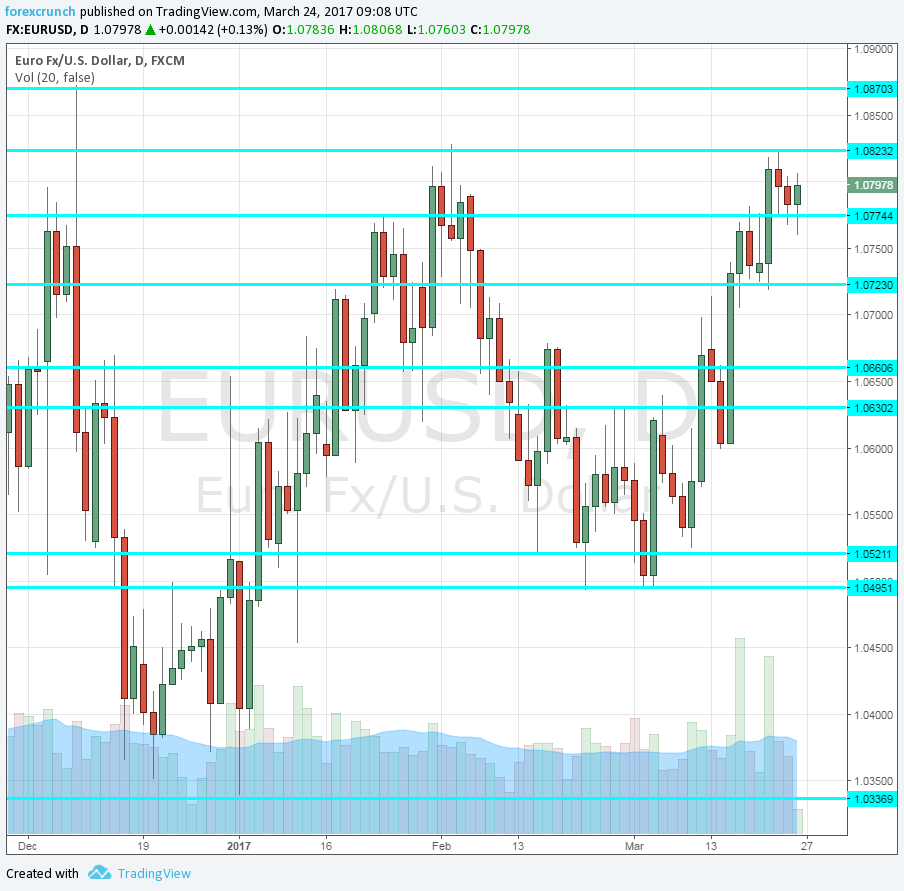EUR/USD had a mixed week. The last week of March features a key survey and fresh inflation figures. Is the ECB’s optimism justified? Here is an outlook for the highlights of this week and an updated technical analysis for EUR/USD.
The French elections seem more favorable to Emmanuel Macron, the mainstream candidate, alleviating fears for a win for Le Pen. Upbeat euro-zone PMIs supported the euro as prospects for growth look brighter. ECB speakers did not raise provide further fuel, but they did not hold the single currency down either. In the US, Fed Chair Yellen also skipped the chance to move the dollar after the dovish hike. The focus was on the chances of Trump passing his health care program.
[do action=”autoupdate” tag=”EURUSDUpdate”/]EUR/USD daily chart with support and resistance lines on it. Click to enlarge:
- German Ifo Business Climate: Monday, 8:00. Germany’s No. 1 Think-tank reported a return to an upbeat sentiment back in February, with a score of 111 points, just like in December, and after a blip in January. A score of 111.2 is on the cards now
- Monetary data: Monday, 8:00. The European Central Bank reports its measures of money in circulation (M3 Money Supply) which rose by an annual rate of 4.9% in January as well as the growth in private loans, which surprised by accelerating to a pace of 2.2%. The figures for February will probably be similar but another uptick in lending will be welcome. M3 is expected to remain at 4.9% and lending to accelerate to 2.3%.
- German Import Prices: Wednesday, 6:00. Prices of imported goods such as energy reach consumers. In the past four months, import prices topped expectations with a rise of 0.9% in January. An increase of 0.4% is predicted.
- German CPI: Thursday, the German states publish their estimates during the morning and the all-German number is made public at 12:00. The largest economy in the euro-zone saw prices rising by 0.6% m/m in February. Rising prices in Germany were fueled by fuel prices more than anything else. A monthly rise of 0.4% is projected.
- Spanish Flash CPI: Thursday, 7:00. Spain went from one of the countries suffering the deepest deflation to a leader in inflation. In the past two months, annual price rises stood at 3%. We now get the flash estimate for March which is expected to stand at 2.6% y/y.
- German Retail Sales: Friday, 6:00. Consumers in the euro-zone’s locomotive have been somewhat cautious, with retail sales missing expectations for three consecutive months. In January, the volume dropped by 0.8%. A rise of 0.7% is forecast now.
- French CPI: Friday, 6:45. French prices increased by a modest 0.1% in February, falling short of expectations. We now get the preliminary data for March. An increase of 0.7% is expected.
- French Consumer Spending: Friday, 6:45. The second-largest economy in the euro-zone enjoyed a bounce back in consumption back in January, a rise of 0.6% was seen. A slower rate of 0.3% is on the cards now.
- German Unemployment Change: Friday, 7:55. Germany’s job market continues being a success story. with drops in the number of the unemployed almost every month. Back in January, 14K people left the ranks of the unemployed. A drop of 10K is expected.
- Flash inflation data: Friday, 9:00. Despite being released after the major countries will have already published their flash inflation estimates, the data still has a significant impact, as headline CPI is the ECB’s mandate. In February, the consumer price index hit the “holy grail” of central banking at 2%, higher than expected. However, core CPI remained stuck at 0.9%. This time, the flash data for March is expected to show a drop in both figures: 1.8% for the headline and 0.8% for the core.
* All times are GMT
EUR/USD Technical Analysis
Euro/dollar traded in range initially, above the 1.0720 level (mentioned last week). It then made a move to the upside, flirting with the 1.0830 level.
Technical lines from top to bottom:
The round number of 1.10 is the high line for now. It is followed by 1.0950.
The swing high of 1.0870 is the swing high in December and remains fierce resistance. 1.0830 is the 2017 high and follows closely.
1.0775 capped the pair in January and remains of importance. 1.0720 was also a high in January.
The pair was unable to crack 1.0660 in February and it remains the high end of the range. 1.0630 is the next level, holding back the pair in February and March.
1.0520 is a relic of the past but still serves as a cap. The more recent low of 1.0490 follows very closely.
Further below, we find the multi-year low of 1.0340. Only 1.0150 separates the pair from parity at this point.
I remain bullish on EUR/USD
Euro-zone data supports the ECB’s tilt to the hawkish side and optimism about Macron also helps. In the US, the Fed does not seem keen to raise rates that quickly and Trump remains embroiled in scandals.
Our latest podcast is titled Murky markets and further Fed fallout
Follow us on Sticher or iTunes

